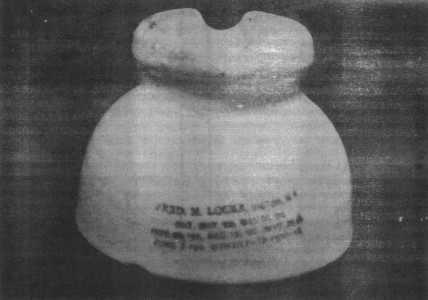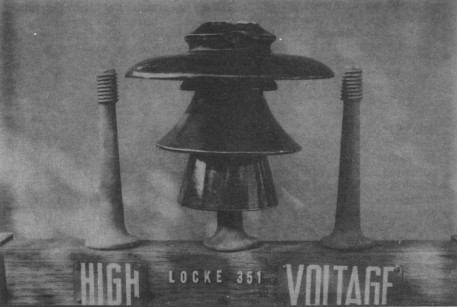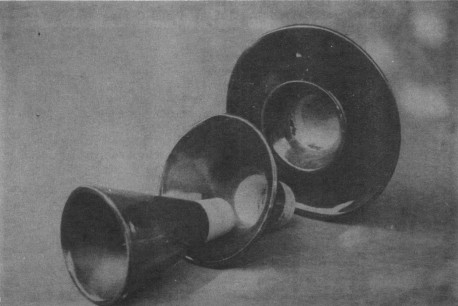Porcelain Insulator News
by Elton Gish, NIA #41
Reprinted from "INSULATORS - Crown Jewels of the Wire", January 1985, page 24
If you will look back at the August issue of Crown Jewels, on page 26 you
will find the report of two white U-3's with Fred Locke markings 0-5 and 6-3.
The following photo is an insulator with a marking never before reported. It is
a white U-610A with a green underglaze 6-3 marking. It is a gift from Mrs.
Milholland.
After the Tacoma National, I had the wonderful opportunity to visit
with Mrs. Milholland at her insulator museum. She is a very gracious lady and
welcomed many of you to her museum. If you are ever in the Tacoma area, it is a
must to visit with her and to browse through the very interesting museum. There
is almost every CD in "The Book", and even a few porcelain insulators
along the floor. That is where I spotted this unusual Fred Locke.

It is a two-piece glazeweld. The inner section was not fitted properly and
remains lopsided. There is also at one spot a gap between the two sections due
to insufficient glaze.
We would like to hear from anyone who has a U-# with a
marking (Fred Locke, Imperial, Lima, etc.) that has not been reported on that
style. There must be others out there.
Dear Elton,
I want to update the article that appeared in the May '84 issue
of Crown Jewels on page 23. The old Victor four-piece porcelain insulator atop
the pole caught my attention immediately after learning of its background
through the owner, Mr. Munkowski. I decided to do further research on this
insulator and try to find one for my collection. About three months later I was
able to acquire two of these, and the owner passed along some information on
their early history.
The insulator was installed in 1905 on a line from the
first hydroelectric plant built on Bishop Creek at Bishop, California, to
Tonopah and Goldfield, Nevada, 115 miles to the east over the White Mountains.
This 55,000 volt line was, at that time, the second highest voltage line in the
nation, and the third longest line in service.
The line was called the "55
KV A and C line" and refers to a double circuit line. One circuit was 4/o
copper, and the other was 4/o aluminum.
This line is still in service. I took a
trip recently into this remote area and observed first hand some of the original
structures plus recent rebuilding with larger new insulators. I was able to
retrieve one of the old units, but, alas, it was in two pieces where the cement
had deteriorated, and came apart between the second and third sections. This is
a common failure that is caused by constant extreme temperature changes over the
past 80 years. The cement breaks down at the greatest stress point, usually
between the second and third sections.
I am enclosing a few color photographs of
this insulator. From a copy of a 1907 Locke catalog, I have determined it to be
the Locke No. 351. The incuse marking VICTOR appears in two places -- on the flat
part of the top skirt and on the side of the small first inner petticoat. The
insulator is 12" tall with a 14" diameter upper skirt.
The line was
built in just over nine months, and today it takes twelve hours by four-wheel
drive vehicle to patrol this 115 mile line.
Robert Reyburn NIA #1584


- - - - - - - - - - -
Dear Robert,
The history on the No. 351 was very interesting. The black and
white copies that I made from your color prints (to run in CJ) do not do it
justice. The glaze color is beautiful. This is a prime example of a "boat
anchor" that is a beautiful display piece with its glaze color and classic
style, without even mentioning the historic background.
Elton
| 